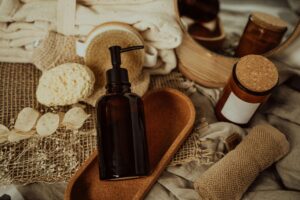Synthetic fragrances are everywhere, from the laundry detergent that washes your clothes to the air fresheners that fill your home with scent. Not to mention—sorry to break it to you—your favorite perfume that absorbs into your skin.
While they may seem harmless, many of these artificially created fragrances come with hidden risks that can impact health and well-being. In this guide, we’ll go over what some of those potential dangers are, as well as safer alternatives.
What are synthetic fragrances? (And the “loophole” that protects them)
Synthetic fragrances are complex mixtures of chemical compounds designed to replicate natural scents. Used widely in cosmetics, personal care products, and household items, they often contain numerous undisclosed ingredients.
That’s because companies can use terms like “fragrance” or “parfum” without revealing the specific chemicals involved—it’s basically a loophole. This lack of transparency creates a challenge for consumers wanting to avoid potentially harmful ingredients. Awareness of this loophole is the first step in making informed choices about personal care products.
The risks of synthetic fragrances
While synthetic fragrances might create a seemingly-pleasant atmosphere, they can also pose various health risks. For starters, it’s important to know what these risks are to make informed choices for both yourself and your family.
1. Allergic reactions
Synthetic fragrances can trigger allergic reactions in sensitive individuals. Symptoms may range from mild irritations to severe respiratory issues. And fragrance allergy is one of the most common causes of contact dermatitis, affecting millions of people each year.
2. Endocrine disruption
Many synthetic fragrances contain endocrine disruptors, which can interfere with the body’s hormonal systems. Phthalates, frequently used to stabilize fragrances, are known to cause reproductive and developmental issues. Exposure to these chemicals can have long-lasting effects on both adults and children, emphasizing the need for caution.
3. Cancer-causing
Some synthetic fragrances have been linked to cancer. Ingredients like benzene, commonly found in synthetic scents (it’s actually one of the 20 most widely used chemicals in the United States), are classified as potential carcinogens by the American Cancer Society.
4. Respiratory and neurological issues
Exposure to synthetic fragrances can lead to respiratory problems, particularly for individuals with asthma or allergies. Some studies suggest that these compounds may contribute to neurological conditions, like migraines and cognitive decline, making it critical to rethink the fragranced products we use in everyday life.
How to avoid synthetic fragrances
When you think about how common synthetic fragrances are in our day-to-day use products, the thought of transitioning away from them can seem daunting. But implementing a few mindful practices can significantly reduce exposure. Here are some tips to help navigate this process.
1. Read ingredient labels carefully
Start by reading the labels of products in your home. Look for terms like “fragrance” or “parfum,” which may indicate the presence of synthetic ingredients, and make a conscious decision to replace these products with more natural alternatives as they run out.
2. Choose trusted brands
Opt for brands known for their commitment to transparency and safety. Many companies now emphasize “fragrance-free” or “naturally scented” options, ensuring they use safe, recognizable ingredients. Research brands and read reviews to find those that align with low tox principles.
3. Switch to essential oils
Essential oils offer a wonderful alternative to synthetic fragrances. These natural scents can enhance your home environment without the negative side effects. Popular essential oils include:
- Lavender: Known for its calming properties.
- Citrus: Uplifting and energizing.
- Eucalyptus: Great for mental clarity and respiratory health.
These oils can be used in diffusers or natural air fresheners, added to bath products, or incorporated into homemade cleaning solutions, providing a safer aromatic experience.
4. Beware of “unscented” claims
It’s essential to understand that “unscented” doesn’t always mean free of synthetic fragrances. Products labeled “unscented” may contain fragrance-masking agents that are still harmful. Look for products that specifically state they are “fragrance-free” to ensure safety.
5. Use ingredient verification apps
Incorporating technology into your shopping routine can simplify the process. Apps like Think Dirty allow you to scan products and access detailed ingredient information. These tools can help identify potential synthetic fragrances and other harmful components, empowering you to make informed choices.
Natural vs synthetic fragrances
Natural fragrances derive from plant sources such as flowers, herbs, and fruits, while synthetic fragrances are chemically manufactured. Generally, natural options are regarded as safer because they do not contain the multitude of harmful chemicals often found in synthetic varieties. However, even natural fragrances can trigger allergies in some individuals, so it’s still a good idea to approach them with caution.
Best alternatives to synthetic fragrances
Essential oils for personal care
Essential oils are a versatile and fragrant alternative to synthetic scents. These natural oils can be incorporated into various personal care products, offering both aromatic benefits and therapeutic properties. Here’s how to use them:
- DIY body oils: Mix your favorite essential oils with a carrier oil (like jojoba or sweet almond oil) to create a personalized body oil. Apply after a shower for a hydrating and fragrant experience.
- Natural perfumes: Combine essential oils like bergamot, jasmine, and sandalwood in a small roller bottle with a carrier oil. This creates a beautiful, customizable perfume that avoids harmful synthetic ingredients. Apply to pulse points for a refreshing scent throughout the day.
Herbal sachets for your home or skin
Herbal sachets can be used in drawers, closets, or even as part of your self-care ritual. Here’s how to make them:
- Create your own sachets: Fill small fabric bags or breathable pouches with dried herbs and flowers such as lavender, rosemary, chamomile, or mint. These natural herbs don’t just smell good but also have calming and relaxing properties.
- Use in skincare routines: Brew herbal sachets in hot water to create soothing herbal infusions. Once cooled, these infusions can be used as facial rinses or added to bath water for a calming soak.
Natural candles for ambiance
While candles are often associated with relaxation and comfort, many commercial options contain synthetic fragrances. Choosing natural candles can create a cozy atmosphere without compromising health:
- Opt for natural wax candles: Look for candles made from soy or beeswax, which burn cleaner than paraffin. These candles often have essential oils for scent, providing a natural and soothing aroma.
- DIY candles: For a fun project, try making your own candles using beeswax or soy wax and essential oils. This way, you can customize the scents to suit your preferences and avoid synthetic additives entirely.
Smell good without the chemicals
As awareness of synthetic fragrances and the risks associated with them continues to grow, more people are choosing to prioritize their health. By opting for natural alternatives and supporting transparent brands, you can still enjoy scents you love—without the negative side-effects.







